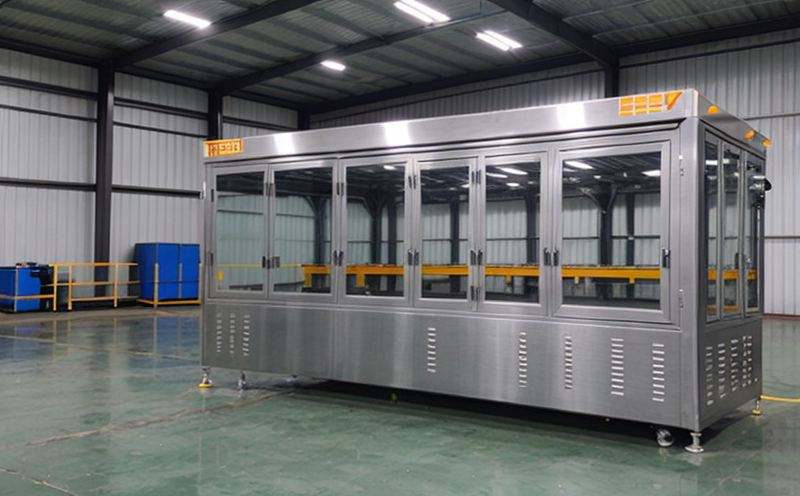ISO 377 Bend Testing of Thin Metals
The ISO 377 standard specifies a method for determining the bendability of thin metal sheets and strips. This test is crucial in quality assurance processes, particularly for industries that rely on metal packaging such as food, pharmaceuticals, and electronics. The primary objective of this testing procedure is to evaluate how well the material can be bent into specific shapes without cracking or losing its structural integrity.
The standard requires the specimen to be prepared by cutting a rectangular strip from the test material with dimensions that are standardized in ISO 377 itself. The bend radius, which is the distance between the inner surface of the bend and the centerline of the bending mandrel, plays a critical role in this testing method. Typically, the bend radius ranges from 0.5 times to three times the thickness of the material being tested.
The testing apparatus consists of a standard mandrel with a specified diameter used for bending the specimen around it. The mandrel is mounted on a fixture that ensures accurate positioning and alignment during the test. Once the specimen is bent, it undergoes visual inspection to check for any cracks or defects along the bend line. If defects are observed, additional tests may be required to assess the material's suitability for packaging applications.
The results of this testing provide valuable insights into the material properties that can influence its performance in real-world scenarios. For instance, in metal packaging design, understanding a material’s bendability is essential for ensuring product safety and stability during manufacturing processes such as forming, filling, and sealing.
- Why Choose This Test:
- To ensure the structural integrity of thin metal sheets used in packaging.
- To comply with international quality standards and regulatory requirements.
- To improve the efficiency and cost-effectiveness of manufacturing processes.
- To enhance product safety and reliability during transportation and storage.
- To support innovation in material selection for sustainable packaging solutions.
- To meet customer expectations regarding package durability and performance.
The ISO 377 Bend Testing is a critical step in the development and validation of metal packaging materials. By adhering to this standard, manufacturers can ensure that their products not only meet but exceed industry benchmarks for quality and safety. This testing method supports continuous improvement efforts aimed at reducing waste and minimizing environmental impact through the use of sustainable materials.
Applied Standards
The ISO 377 standard is widely recognized as a benchmark in the metal packaging sector, providing clear guidelines for conducting bend tests on thin metals. This international standard ensures consistency across different laboratories and regions, which is crucial for maintaining high-quality standards globally.
The testing procedure outlined in ISO 377 involves several key steps that are critical to achieving accurate results. These include selecting the appropriate mandrel size based on the thickness of the metal specimen, preparing the specimen according to specified dimensions, applying the bend force uniformly around the mandrel, and inspecting the bent sample for any signs of damage or defects.
Compliance with these standards is essential for industries that demand high-quality packaging materials. By adhering strictly to ISO 377, manufacturers can ensure that their products meet the stringent requirements set forth by regulatory bodies worldwide. This not only enhances consumer trust but also supports long-term business success through consistent product quality.
Why Choose This Test
- To ensure compliance with international standards and regulations.
- To enhance the structural integrity of metal packaging materials.
- To improve manufacturing efficiency and cost-effectiveness.
- To meet customer expectations regarding product safety and reliability.
- To support innovation in material selection for sustainable packaging solutions.
- To provide valuable insights into the performance characteristics of thin metals under bending stress.
Bend testing is particularly important for metal packaging as it helps identify materials that can withstand the rigors of manufacturing processes while maintaining their integrity. This ensures that products are safe, stable, and reliable throughout their lifecycle. By choosing ISO 377 Bend Testing, businesses can gain a competitive edge in the market by delivering superior quality products.
Environmental and Sustainability Contributions
Bend testing plays a significant role in promoting sustainability within the metal packaging industry. By ensuring that materials are capable of withstanding bending without compromising their structural integrity, this test helps minimize waste during manufacturing processes. This contributes to reducing the environmental footprint associated with production.
Furthermore, by selecting bendable metals for packaging applications, manufacturers can contribute to resource conservation efforts. Flexible and reusable metal packaging solutions not only reduce the need for single-use plastics but also promote recycling initiatives, thereby fostering a more sustainable circular economy.
The results of ISO 377 Bend Testing aid in the development of environmentally friendly packaging designs that balance performance with sustainability goals. For instance, bend testing can help identify materials that are both durable and recyclable, which is essential for reducing landfill waste and promoting responsible consumption practices.





